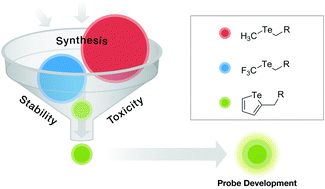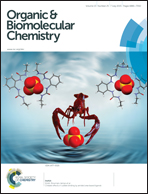Organotellurium scaffolds for mass cytometry reagent development†
Abstract
Mass cytometry (MC) is a powerful tool for studying heterogeneous cell populations. In previous work, our laboratory has developed an MC probe for hypoxia bearing a methyl telluride mass tag. The methyl telluride was unoptimized, displaying stability and toxicity limitations. Here, we investigate three classes of organotelluriums as MC mass tags: methyl tellurides, trifluoromethyl tellurides and 2-alkyl-tellurophenes. NMR was used to compare the stability of these compounds in aqueous and organic solutions and the compounds were analysed for toxicity in Jurkat cells. The methyl tellurides were moderately stable to aerobic oxidation in organic solution under dry ambient conditions. The trifluoromethyl tellurides were stable to aerobic oxidation in organic solution but decomposed in aqueous solution. The 2-alkyl-tellurophenes proved to be stable in both organic and aqueous solutions under ambient conditions and showed limited toxicity (IC50 > 200 μM) in cell based assays. The synthetic feasibility, chemically stability, and limited toxicity of tellurophenes suggests these groups will be good choices for MC reagent development.


 Please wait while we load your content...
Please wait while we load your content...